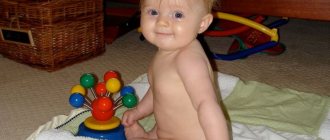Why pick up a child?
At first glance, this question may seem completely meaningless. But many are sure that the baby should be picked up only when absolutely necessary. This is due to the fact that young mothers are intimidated with horror stories about hand training their children. It is believed that if you take the baby in your arms often, he will get used to it and will constantly be capricious and ask to be held. But if you are not a fan of playpens and cribs, then you will have to carry your baby often. By the way, this is useful for the newborn itself. There is more than one good reason for this.
- The baby needs physical contact with his mother. In this way he feels love and the attachment of the child and mother to each other is strengthened.
- In the arms of a mother or another adult, it is easier for a baby to learn about the world around him. After all, he views space from a different angle. He gets acquainted with people, phenomena and new objects.
- If you carry your baby in your arms correctly, this will contribute to the normal physical development of the baby.
Video GUIDE: how to properly hold and carry a newborn
All women, becoming mothers, ask the question: how to properly hold a newborn? After all, he is still so small, fragile, and it’s scary to touch him, lest he do harm or hurt. Holding a baby correctly is actually not that difficult. The main thing is to do it carefully.
Place the baby on the surface
It is important to be able not only to pick up a baby, but also to put it back. You should lower it into the crib, changing table or other surface very carefully, while holding your butt and the back of your head with your palms. At the same time, not only lower your arms, but also tilt your body. This will make it easier for you to control the movement of your hands. You are, as it were, insuring the baby from landing abruptly in the crib.
When the baby touches the crib, you should wait 3-4 seconds, and only then remove your hands. It is recommended to do this because the child needs to get used to the new position a little. This way he will not be afraid and will feel the new support on which he was placed.
Deviations from the norm: causes and proper correction
Some people hold their heads immediately after birth, others only at 6 months, and there are children for whom this is especially difficult. And sometimes the mother notices that the baby holds his head to one side or to one side. There are a number of reasons that prevent a child from mastering the necessary skill fully and in a timely manner:
- Hypotonicity. The baby's muscles may not yet be strong enough to cope with the task.
- Prematurity. If the baby was born too early, then he may naturally lag behind his peers in physical development.
- Light weight of the child. This happens both due to prematurity and for other reasons related to nutrition or some disease.
- Rarely laying on the stomach. If the baby is on his back most of the time, he does not have the opportunity to independently train his muscles and raise his head.
- Neurological reasons. They can occur as a result of a pathological pregnancy or childbirth, or injuries to the child during and after birth.
The child tilts his head to one side
When parents notice that the baby is tilting his head in the same direction, they should consult a doctor. The main causes are congenital muscular torticollis or muscle hypertonicity. Installation torticollis is also possible. To distinguish one from the other, you need to watch the child.
- Congenital muscular torticollis. The head is slightly thrown back and tilted towards the shoulder, while the face is turned in the opposite direction. The back of the head is slightly sloping, one shoulder is lower than the other. There is slight facial asymmetry. Sometimes a child may notice a delay in psychomotor development. Symptoms appear immediately after birth. ICH occurs due to intrauterine underdevelopment of the sternocleidomastoid muscle or after injuries received during childbirth.
- Muscle hypertonicity (false torticollis). Increased tone is a fairly common occurrence in infants. It can cause tension in the neck muscles, causing the baby to hold his head unevenly. Hypertonicity is noticeable from birth. You can determine it by looking at the child’s other muscle groups. Arms and legs will be bent, fists clenched even during sleep. As the baby grows older, the hypertonicity goes away and the muscles relax.
- Installation torticollis. Incorrect head position can be an acquired problem. When the parent always approaches the child from one side, the toys are located only on the right or left, the baby has no incentive to look in the other direction. As a result of this, he may develop a habitual head tilt to one side.
Any torticollis requires immediate correction
Only a doctor can make a correct diagnosis and prescribe therapy. Non-drug principles for the treatment of all types of torticollis are the same: physical therapy, including positional treatment (special head positioning), massage.
Newborn holds head too early
If a baby begins to hold his head from birth, doctors often diagnose “muscle hypertonicity.” To relieve tension and strengthen the muscle corset, massage and gymnastics are usually recommended.
Muscle tone is often observed in newborns and children in the first year of life. Do not be alarmed, because at first this is a normal condition caused by the baby getting used to the new body position after the fetal position. Violations of tone require observation by a neurologist and correction.
Should you do a massage if you have hypertension - Doctor Komarovsky - video
The baby stopped holding his head up after the first month
It happens that the baby held his head well during the first month, but then stopped doing so or began to hold his head unsteadily. Most likely, this occurred as a result of the disappearance of hypertonicity. Since the muscles are no longer in constant tension, the baby must train them and learn to lift his head on his own. If a child stops holding his head up at an older age, this may be an unpleasant symptom of some disease or injury.
In any case, if the baby has stopped holding the head on his own, this is a reason to contact a neurologist.
Holding a baby in our arms
When you hold your baby, he may be in several different positions. This is useful for both parents and the baby himself. This is useful for adults because it will help prevent muscle strain. With different methods of support, different muscle groups will be under tension. At the same time, the child himself will also train different muscles. In addition, the baby will be able to examine the space from different angles.
Cradle
This method is classic and allows you to keep the baby in a horizontal position. The baby just lies in his arms, as if he were in his own cradle. The head is on the elbow of the person holding it, while the second hand clasps the small body, and also holds the back and butt. The baby's body is turned with its tummy towards the adult who is holding it.
If parents hold the baby in this way very often, then they should definitely change hands. The head should lie alternately on the left and then on the right hand. This is good for the child. Indeed, in this case, prevention of torticollis and problems with the spine is ensured.
Column
Children are usually carried in this position after feeding. After all, this is the easiest way to burp the excess air that has accumulated in the ventricle during feeding. When holding your baby in this position, you should be sure to support the entire spine and also support the head. In this case, the baby is placed facing you, and the chin is placed on his shoulder. You need to firmly support your lower back and neck with your hands.
But it is important to remember that in a vertical position, a load is placed on the newborn’s spine that cannot be called useful. You should not often carry your baby in the column position. You can limit yourself to 5-7 minutes after feeding.
Holding a newborn upright is allowed, facing away from you. In this case, the head should be placed on your shoulder. You need to firmly support the legs and chest with your hands.
On the tummy
Little children simply love to “fly” face down. In this position, colic is prevented and gases are better released after eating. Young parents, having heard enough horror stories about how they can’t put a newborn on their tummy in a crib, are afraid to do it. Carrying a baby in your arms, facing down, is much calmer for them.
To hold the baby with his tummy down, one of your palms should be placed on his chest. In this position, your chin should rest on your elbow. We hold the baby's tummy with our other hand, passing it between his legs.
When you hold your child in this position, his back muscles are better trained and his neck is strengthened. Therefore, children who are often held this way begin to hold their heads on their own earlier.
Like Buddha
In this position the child will be positioned in the same way as the Buddha. But this cannot be called a full-fledged sitting. The adult holds the baby, and he rests his head on his chest and leans his back. One hand holds the breast, and the other holds the legs. In this case, the feet are folded together. This position is similar to the lotus position.
It may seem that the baby is uncomfortable in this position. But for a baby this position is natural. You just need to remember what position it takes when it develops in the womb. Spreading the legs in this way will benefit the baby. This is the prevention of joint dysplasia.
Position of the baby during procedures
Another question interests literally every parent: how to hold the baby during bathing and other hygiene procedures. Usually mothers receive similar answers back in the maternity hospital:
- When you simply wash your baby under the tap, hold him face up with the baby's head in the crook of your elbow. That is, they hold the baby with one hand, holding it by the thigh, and wash it with the other when the second leg hangs down.
- When the newborn grows up, you can wash in a different position - most often it is “face down”, holding the baby by one thigh in the same way.
- When a baby is bathed, he is held by the head and bottom so that the baby's chin is above the water level.
Don’t be afraid to carry your baby in different ways, don’t listen to restless relatives of older generations: different positions of the baby in your arms help him explore the world and develop muscles. And don’t forget that the baby really needs your hugs, so don’t deprive him of such joy.
What not to do
When holding a child in your arms, you should remember what not to do.
- Do not lift the baby by holding the arms or hands by the wrists. After all, the joints have not yet become stronger, which can lead to injury.
- Never lift the baby without holding the head with your palm. After all, the neck of newborns is also very weak. If the head is not supported, it will tip over. This will cause discomfort to the baby.
- If you have already picked up your baby, you must always ensure that the limbs do not hang down.
- If you hold your baby upright, be sure to support the back. Indeed, in this position a significant load is created on the spine, which at this age is harmful for the baby. The consequences of such incorrect support may even take some time to appear. This occurs at approximately 5-6 years of age.
- Try to be careful not only when lifting or lowering your baby, but also when holding him. You need to hold it securely, but not press down too hard.
What not to do
- Under no circumstances should you allow your newborn's head to be thrown back. This will negatively affect the formation of the spine, and can also lead to quite sad consequences, because the baby’s bones have not yet had time to get stronger and form.
- You should also not squeeze or hug your baby too much, as this will make her feel uncomfortable and anxious.
- It is not recommended to pull the baby by the hands and feet, as in children the bones can easily come out of the joints. For such games, it is better to wait until the child’s skeleton is formed and strengthened.
- It is undesirable for the baby's arms and legs to hang down when he lies in his mother's arms.
- It is not recommended to carry the baby on one side: you need to move it from left to right and vice versa.
When bathing your baby, it is important that his head has reliable support.











